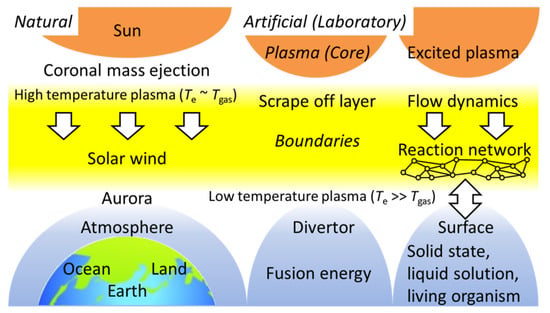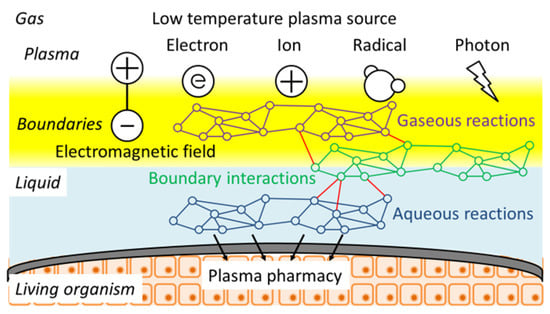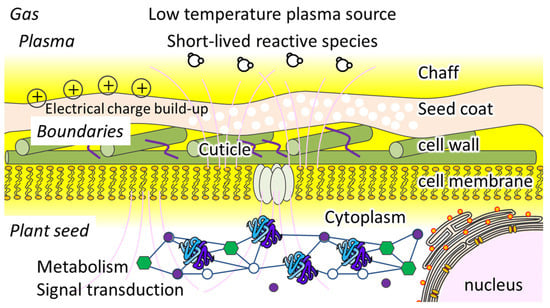You're using an outdated browser. Please upgrade to a modern browser for the best experience.
Please note this is an old version of this entry, which may differ significantly from the current revision.
Subjects:
Physics, Fluids & Plasmas
Plasma-driven science is defined as the artificial control of physical plasma-driven phenomena based on complex interactions between nonequilibrium open systems.
- plasma-driven sciences
- plasma processing
- plasma-wall interactions
1. Introduction
In the universe, space is filled with matter that interacts electromagnetically with the remaining unresolved energy. As matter is energetically excited, excited states involving electrons and ions are formed from particles in the ground state. The collection of ionized matter is known as plasma. The plasma state can be found naturally or artificially in various situations.
Plasma phenomena have been studied in the natural sciences in subjects such as cosmic plasma physics, astrophysics, atmospheric physics, and chemistry, as well as laboratory plasmas such as laser-produced plasma and magnetically confined plasma to create fusion energy. The central region is a high-temperature plasma surrounded by the boundary region that forms a low-temperature plasma (LTP) and, upon detaching, usually flows toward the edge and generates secondary processes at the boundary (Figure 1). At the boundary, secondary processes involve plasma-induced molecular dissociations providing electronically neutral particles called radicals, which are chemically reactive and often have unpaired electrons. The chemically rich reaction field artificially produces interactions between plasma-generated particles, such as electrons, ions, radicals, and photons, which are triggered by electron collision-induced reactions. Plasma processes at the boundary layer are critical and are observed in various fields, such as film deposition and material etching, plasma medicine, plasma agriculture, and plasma pharmacy. In the interactions of plasma with solid-state materials, liquids, and living organisms, the mechanisms explaining these mysterious phenomena have not yet been comprehensively clarified. The unique characteristics of the LTP technology are the nonequilibrium nature of temperature-independent chemical reactions and the fact that artificial plasma generation mimics the chemistry-rich and nonlinear dynamic nature of physicochemical reactions.

Figure 1. Plasma boundaries for the complex interaction of natural (left) and artificial (right) plasma-related phenomena. Complex interactions between the systems occur at the interfaces when facing the excited plasma to the counter surface for solid-state materials, liquid solutions, and living organisms. In the phase boundary surface, plasma generates particles, such as electrons, ions, radicals, and photons, in the excited plasma transport-based flow dynamics and creates a chemical reaction network. As energy flow one direction from the source plasma to surface of matters, Sun–Earth relationship is mimicked to form the plasma boundary regions in cases of various laboratory plasma fields.
2. Plasma-driven Phenomena
2.1. Artificial Plasma Generation in Nominal Conditions (Temperature and Pressure)
The separation of the gas temperature from the electron temperature is characterized by the arc- and glow-like features at high and low gas temperatures, respectively. Previously, a method was developed to generate stable glow-like plasma under atmospheric pressure without increasing the gas temperature. Subsequently, LTP sources have been developed over a long history [1]. High plasma densities and frequent repetitions have been reported.
LTP provides a nonequilibrium reaction field for chemically reactive species without thermal heating [2]. Hydrogen plasma chemical reactions can be explained by molecular-activated recombination (MAR)[3][4]. This study demonstrates the importance of electronically and vibrationally excited state molecules in understanding anomalously fast plasma recombination.
Similarly, nitrogen plasma chemical reactions compete between oxidation and reduction and the nitrogen cycle is relevant to redox reactions. For example, stable dinitrogen can be functionalized with ammonia by forming nitrogen atoms using plasma discharge technology. In product life assessments, the circulation of elements such as carbon, nitrogen, and rare metals has become an issue. In situ functionalization of resources can be achieved using plasma-driven catalysts [5]. Nitrogen fixation occurs under air and water discharge and can be used as a fertilizer in agriculture.
2.2. Emergence of Plasma–Liquid Interactions
Similarly, plasma contacts liquid solutions, and materials are created in them. Plasma–liquid interactions induce some beneficial effects, and the gain of pharmaceutical effectiveness has emerged and is called plasma pharmacy (Figure 5). Eventually, the plasma-contacting liquids kill the cells of living organisms during cultivation in Petri dishes [6]. Comprehensive chemical analyses have shown that plasma-treated liquids contain inorganic reactive species, known as reactive nitrogen and oxygen species (RONS), such as hydrogen peroxide (H2O2), nitrous acid (HNO2), and nitric acid (HNO3) [7]. The nitrogen-based reactive species, HxNyOz, plays a role in the chemical reactions [8].

Figure 5. Plasma-pharmacy: The rich chemistry in the plasma-induced aqueous reactions including dehydration, esterification, hydrolysis, and dimerization of the original organic molecules. The chemical reactions can be represented by networks with nodes for reactants and products, and paths for elementary reactions. Hierarchically, the reactions occur across phase boundaries. Reactive species created by multiple reactions on the network are functionalized in situ for biological effectiveness.
A plasma-treated culture medium contains various organic reactive species. When Ringer’s lactated solutions, containing sodium lactate (Na-C3H5O3), sodium chloride (NaCl), potassium chloride (KCl), and calcium chloride (CaCl2) are used, other organic substances that can kill cancer cells without killing normal cells are generated in the plasma-treated lactated solutions, called plasma-activated solutions (PAL). During the plasma treatments of the lactated solutions, a hydroxyl radical (●OH) is generated and reacted with the alcohol moiety of the lactate skeleton. The ●CH- and ●CH2- type radicals on the lactate skeleton are formed by the hydrogen abstraction due to the ●OH radical. In aqueous chemistry, organic acids such as acetate, pyruvate, and glyoxylate are derived from decomposition and oxidation[9]. Moreover, dimerization occurs to form substances, such as 2,3-dimethyltratrate , and additive reactions create products containing methyl amine groups [9]. These examples exhibit rich chemistry in plasma-induced aqueous reactions, including the dehydration, esterification, hydrolysis, and dimerization of the original organic molecules.
In simplification, oxygen radicals are separated from the plasma source, without electrons, ions, and photons, and when oxygen radicals are irradiated into the solutions, bactericidal effects of the oxygen radical-treated solutions have been reported [10]. Recently, the bactericidal effects of l-Tryptophan (Trp)-containing solutions were reported, and the bactericidal effect was found [11]. After the oxygen radical irradiation, products, such as kynurenine and N’-formyl kynurenine, were observed to be stable in the solution. However, the bactericidal effect was obtained only by in situ irradiation with oxygen radicals. The in situ reactions form the short-lived tryptophan radical (Trp●) that is an intermediate precursor for transformation from Trp to kynurenine reaction scheme [11]. The authors indicated that oxygen radical irradiation transformed organic fertilizer into a bactericide. Until now, short-lived species have not been a concern; however, controlled plasma-driven phenomena can be used as pharmaceutical drugs. There are no clear advantages and disadvantages of plasma-generated products, together with oxidative or reductive stimuli toward living organisms; the plasma pharmacy is irreplaceable and its low invasiveness precludes no alternative method.
2.3. Plasma Seed Science: Enhancement of Germination and Growth of Plant Seeds
Regarding the interactions between plasma and living organisms, the inactivation of pathogenic microorganisms, bacteria, and viruses has been observed after plasma treatment without damaging agricultural products. Several studies have reported that direct plasma irradiation of plant seeds promotes germination and growth [12]. In the physiological process of seed germination, regulation of the balance of phytohormones, such as abscisic acid (ABA) and gibberellin (GA), stops dormancy, seed metabolism synthesizes enzymes, and seed germination occurs during seedling processes with regard to the softening of the cell wall and expansion of the shoot and root. The mechanical properties of seeds change during physiological germination. Atmospheric pressure air plasma releases dormancy in Arabidopsis thaliana seeds and modifies the glass-to-rubber transition temperatures of seed coats. Protein delay of germination 1 (DOG1) is the master regulator of seed dormancy, enhancing ABA signaling and interactions with phosphatases. Seed dormancy 4 like 1 (SFL1) positively regulates the termination of the seed dormancy program.
In the other case, when the A. thaliana seeds are treated by low-pressure oxygen plasma, the expression of epigenetic-related genes of DME regulates DNA methylation and RNA-directed DNA methylation (RDM4). Epigenetic changes determine the production of enzymes that catalyze reactions regulating DNA demethylation and histones associated with the chromosomal region of the gene. More recently, epigenetic regulation of methylation and acetylation of the DNA-promotor regions of ABA metabolism and α-amylase was altered by the plasma irradiation of rice seeds, and germination of heat-stressed seeds was restored [13] (Figure 6).

Figure 6. Plasma seed science. Elucidation of mechanisms of the epigenetic alternation of phenotypes of seeds due to a short-time plasma irradiation. Reactive species transport inside porous chaff and coats of seeds, and biochemical reactions may alter the methylation or acetylation of the cytosine base of DNA or the lysine residue of histones of nucleosomes.
Because seeds have a storage lifetime, their senescence leads to a decrease in germination rates. Seed color and radical concentrations measured by electron spin resonance (ESR) affect both the germination rate and plant growth [14]. High nitrate concentrations have been reported in plasma-treated seeds with no significant risks [15][16]. When plasma treatments were performed during the cultivation of rice plants in paddy fields, the quality of the rice seeds improved [17][18].
Plasma treatment plays an important role in biological stimulation. Stimuli above the normal level of organization are provided for short periods, leading to the chemical, biochemical, and biological responses observed in the relaxation process. Plasma triggers irreversible changes in dynamics. This behavior occurs as a chemical change based on physical action. This response is a characteristic function of the amount of trigger stimulation, which is a low-dose stimulus that is harmful at high doses. Intense and short-lived stimuli act as coherent processes, resulting in a synergistic effect even at low doses.
This entry is adapted from the peer-reviewed paper 10.3390/plasma7010011
References
- Kenji Ishikawa; Keigo Takeda; Shinji Yoshimura; Takashi Kondo; Hiromasa Tanaka; Shinya Toyokuni; Kae Nakamura; Hiroaki Kajiyama; Masaaki Mizuno; Masaru Hori; et al. Generation and measurement of low-temperature plasma for cancer therapy: a historical review. Free. Radic. Res. 2023, 57, 239-270, .
- Shinji Yoshimura; Yoko Otsubo; Akira Yamashita; Kenji Ishikawa; Insights into normothermic treatment with direct irradiation of atmospheric pressure plasma for biological applications. Jpn. J. Appl. Phys. 2020, 60, 010502, .
- A.Yu Pigarov; S.I Krasheninnikov; Application of the collisional-radiative, atomic-molecular model to the recombining divertor plasma. Phys. Lett. A 1996, 222, 251-257, .
- N Ohno; Plasma detachment in linear devices. Plasma Phys. Control. Fusion 2017, 59, 034007, .
- Toshiro Kaneko; Hiromitsu Kato; Hideaki Yamada; Muneaki Yamamoto; Tomoko Yoshida; Pankaj Attri; Kazunori Koga; Tomoyuki Murakami; Kazuyuki Kuchitsu; Sugihiro Ando; et al. Functional nitrogen science based on plasma processing: quantum devices, photocatalysts and activation of plant defense and immune systems. Jpn. J. Appl. Phys. 2021, 61, SA0805, .
- Hiromasa Tanaka; Kenji Ishikawa; Masaaki Mizuno; Shinya Toyokuni; Hiroaki Kajiyama; Fumitaka Kikkawa; Hans-Robert Metelmann; Masaru Hori; State of the art in medical applications using non-thermal atmospheric pressure plasma. Rev. Mod. Plasma Phys. 2017, 1, 1-89, .
- Yang Liu; Kenji Ishikawa; Hiromasa Tanaka; Camelia Miron; Takashi Kondo; Kae Nakamura; Masaaki Mizuno; Hiroaki Kajiyama; Shinya Toyokuni; Masaru Hori; et al. Organic decomposition and synthesis reactions in lactated solution exposed to nonequilibrium atmospheric pressure plasma. Plasma Process. Polym. 2023, 20, 2200193, .
- Kenji Ishikawa; Perspectives on functional nitrogen science and plasma-based in situ functionalization. Jpn. J. Appl. Phys. 2021, 61, SA0802, .
- Hiromasa Tanaka; Yugo Hosoi; Kenji Ishikawa; Jun Yoshitake; Takahiro Shibata; Koji Uchida; Hiroshi Hashizume; Masaaki Mizuno; Yasumasa Okazaki; Shinya Toyokuni; et al. Low temperature plasma irradiation products of sodium lactate solution that induce cell death on U251SP glioblastoma cells were identified. Sci. Rep. 2021, 11, 1-10, .
- Naoyuki Iwata; Vladislav Gamaleev; Hiroshi Hashizume; Jun‐Seok Oh; Takayuki Ohta; Kenji Ishikawa; Masaru Hori; Masafumi Ito; Simultaneous achievement of antimicrobial property and plant growth promotion using plasma‐activated benzoic compound solution. Plasma Process. Polym. 2019, 16, 1900023, .
- Naoyuki Iwata; Kenji Ishikawa; Yasuhiro Nishikawa; Hiroyuki Kato; Motoyuki Shimizu; Masashi Kato; Hiromasa Tanaka; Masafumi Ito; Masaru Hori; Oxygen radical irradiation transforms an organic fertilizer l-tryptophan into an environment and human-friendly bactericide. Environ. Technol. Innov. 2024, 33, 103496, .
- Pankaj Attri; Kenji Ishikawa; Takamasa Okumura; Kazunori Koga; Masaharu Shiratani; Plasma Agriculture from Laboratory to Farm: A Review. Process. 2020, 8, 1002, .
- Chetphilin Suriyasak; Kota Hatanaka; Hayate Tanaka; Takamasa Okumura; Daisuke Yamashita; Pankaj Attri; Kazunori Koga; Masaharu Shiratani; Norimitsu Hamaoka; Yushi Ishibashi; et al. Alterations of DNA Methylation Caused by Cold Plasma Treatment Restore Delayed Germination of Heat-Stressed Rice (Oryza sativa L.) Seeds. ACS Agric. Sci. Technol. 2021, 1, 5-10, .
- Pankaj Attri; Kenji Ishikawa; Takamasa Okumura; Kazunori Koga; Masaharu Shiratani; Vida Mildaziene; Impact of seed color and storage time on the radish seed germination and sprout growth in plasma agriculture. Sci. Rep. 2021, 11, 1-10, .
- Takamasa Okumura; Pankaj Attri; Kunihiro Kamataki; Naoto Yamashita; Yuichi Tsukada; Naho Itagaki; Masaharu Shiratani; Yushi Ishibashi; Kazuyuki Kuchitsu; Kazunori Koga; et al. Detection of NO3− introduced in plasma-irradiated dry lettuce seeds using liquid chromatography-electrospray ionization quantum mass spectrometry (LC-ESI QMS). Sci. Rep. 2022, 12, 1-11, .
- Takamasa Okumura; Hayate Tanaka; Takumi Nakao; Teruki Anan; Ryo Arita; Masaki Shiraki; Kayo Shiraki; Tomoyuki Miyabe; Daisuke Yamashita; Kayo Matsuo; et al. Health assessment of rice cultivated and harvested from plasma-irradiated seeds. Sci. Rep. 2023, 13, 1-8, .
- Hiroshi Hashizume; Hidemi Kitano; Hiroko Mizuno; Akiko Abe; Genki Yuasa; Satoe Tohno; Hiromasa Tanaka; Kenji Ishikawa; Shogo Matsumoto; Hitoshi Sakakibara; et al. Improvement of yield and grain quality by periodic cold plasma treatment with rice plants in a paddy field. Plasma Process. Polym. 2020, 18, 2000181, .
- Hiroshi Hashizume; Hidemi Kitano; Hiroko Mizuno; Akiko Abe; Genki Yuasa; Satoe Tohno; Hiromasa Tanaka; Kenji Ishikawa; Shogo Matsumoto; Hitoshi Sakakibara; et al. Efficacy of periodic cold plasma treatment in a paddy to produce white-core grains in brewer’s rice cultivar Yamadanishiki. Free. Radic. Res. 2023, 57, 161-173, .
This entry is offline, you can click here to edit this entry!
